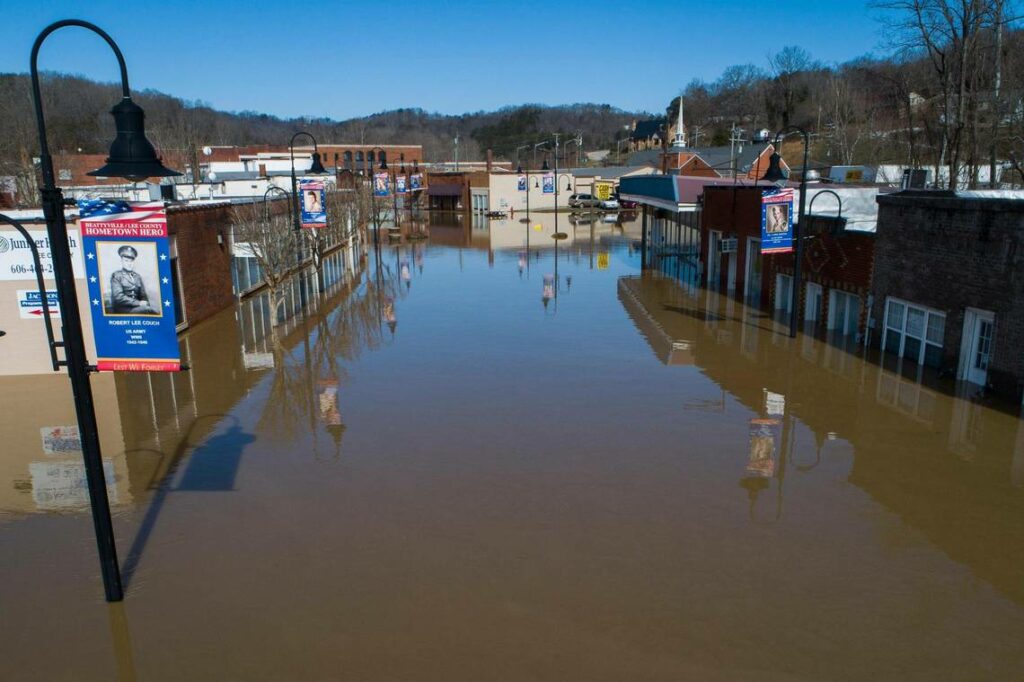Within our lifetimes, devastating floods have become more frequent throughout Eastern Kentucky. It’s not just in our imaginations; the EPA has found that there has been a 27 percent increase in heavy rainfall events across the Southeast in the last 65 years. As the climate shifts, we have to do our best to prepare our beloved mountain homes and communities.
I am writing this from my office, located in one of Hazard, Kentucky’s Special Flood Hazard Areas as designated by FEMA. My home, located nearby, is also in the flood zone. We became homeowners in 2012 – the very year when the National Flood Insurance Program (NFIP) was bankrupted and flood insurance premiums, which my lender required, quadrupled. The NFIP has since been in a state of flux as the government pivoted to try and figure out how to build the program back in a better, more sustainable way. As someone with an NFIP policy and as someone who does community economic development in Eastern Kentucky, I have been closely watching the changes.
First, some quick background. The NFIP was created in the 1960s in response to flood insurance on the private market being outrageously expensive. This program was meant to share the financial risk across all properties enrolled in the program, and subsidize the cost of flood insurance premiums. After payouts from Hurricanes Katrina and Sandy bankrupted the program, Congress passed the Biggert-Waters Act in 2012 to eliminate the subsidy for repeat claimants, businesses and second or third homes. That fix, however, also raised rates for many homes in Eastern Kentucky. This caused everyone’s policies to jump through the roof until the Obama administration capped premium increases at 18 percent per year.
This Act also mandated that FEMA update maps to be based on risk in an effort to make rates more fair across the nation. FEMA’s Risk Rating 2.0 went into place for new policies in October 2021 and will go into effect for existing policies beginning this April as they renew. Under the old system, flood insurance was based on the lowest floor of your dwelling as compared to your area’s base flood elevation. Now, with 2.0, it’s not only elevation of your property, but proximity to water sources, what type of flooding you’re likely going to experience, cost to rebuild your home, how many times you’ve filed claims in the last 20 years, and many other factors that are considered.

Photo from the Herald Leader.
By basing premium rates on risk, the hope is that individuals will no longer pay more than their share based on the value of their homes, and that NFIP will be here for generations to come. With this new pricing, rates are going down for people who may need it most. Roughly two-thirds of policyholders with older homes – those built before flood protection construction practices and before most communities had comprehensive floodplain regulation – will see a premium decrease. In Perry County, for example, 36 will see a decrease of more than $100 per month.
The intent of the risk rating system is to discourage investment in areas likely to create a burden on the NFIP. But if we as communities do things to decrease our flood risk, policies can become more affordable under FEMA’s Community Rating System (CRS). Communities can earn NFIP rate discounts of 5 to 45 percent if they meet criteria for the CRS classification. Currently, policyholders in eligible CRS communities save an average of $162, or 15 percent, per year on their flood insurance policy. To date, there are 24,500 communities that participate, but as of October 2020, there were only 41 communities enrolled in Kentucky.
Because flood insurance has been costly, there are not many flood policies in our area. In fact, there are less than 20,000 NFIP policies in Kentucky. But with our climate changing, we know the floods will keep coming and we have to look at all our options. Part of the changes by FEMA have allowed insurance agents to more easily draw up quotes for people interested in flood insurance. I would encourage everyone to investigate whether the changes have made flood insurance a more affordable option. If you are renting, you may be able to get flood insurance on the contents of your home. Outside of insurance, FEMA’s Kentucky website offers some simple ideas for how homeowners and renters can prepare for wet weather, and other specific, practical ideas for how local leadership can help us. Your local flood plain coordinator may also be a good resource for you to learn more.
Les Roll is the Special Projects Manager at the Mountain Association. He can be reached at les@mtassociation.org.
This article was a guest editorial for the Daily Independent, Carter County Times and other local papers in spring 2022.






